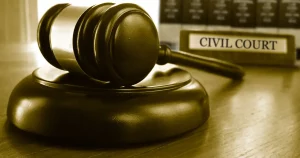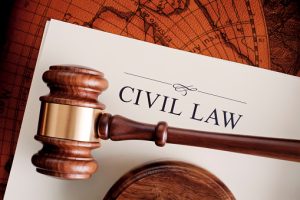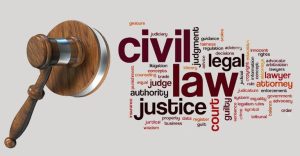Table of Contents
Introduction
Code Of Civil Procedure is a procedural law that has been created to Implement the substantive rights of a person, given by substantive law provided these rights are infringed. However, the rights being infringed must be of Civil Nature. Any rights of moral nature are not dealt with in the CPC.
In Civil Law, the scope of civil wrongs is very wide and there can be new types of civil wrongs without any precedent thus, every civil court has been given the inherent powers to decide these cases in the Interest Of Justice.
What is a Civil Suit
Civil Suit is basically the creation of the CPC. Section 26 of CPC says, ‘Every civil proceeding starts with a suit and every suit shall be instituted by a Plaint.’ Suit ordinarily means a civil proceeding instituted by a presentation of a Plaint. In the case of Hans Raj Gupta vs Official Liquidator of Dehradun, 1933, it laid down the essentials of a civil suit:
- There must be a cause of action.
- There must be a demand for relief or claim.
- There must be a dispute or controversy.
- There must be two opposite parties.
What are Suits Of Civil Nature
Civil Nature gives a wider meaning to the word Civil. It determines something which is more than civil but similar to the meaning of Civil. The word Civil Nature encompasses not only strictly civil proceedings, but also includes proceedings which are essentially of civil nature. It gives the fundamental qualities of a thing, essential character of a thing and essence of a particular thing.
In the case of Sinha Ramanuja V. Ranga Ramanuja, 1961, “Suit of civil nature particularly refers to private rights and obligations of the parties i.e (principal question in the suit is pertaining to civil nature as a general rule). If the principal question in a suit is pertaining to caste or religion or political question then it will not be considered to be a suit of civil nature.
However, if the principal question in a suit is pertaining to civil nature but its adjudication incidentally involves determination of caste or religion question as well then civil court will not be barred to try such a suit and such suit shall not be barred to be a suit of civil nature.”
According to Section 9 of the code, Suits of civil nature included:
- Suits relating to rights in property.
- Suits relating to restitution of conjugal rights.
- Suits for dissolution of marriage.
- Suits pertaining to rents.
- Suits for damages for civil wrong.
- Suits for specific performance of contract.
- Suits for specific reliefs.
Exception Of Suits Of Civil Nature:
- Suits involving questions relating to religious rites and ceremonies.
- Suits involving caste questions.
- Suits pertaining to expulsion from caste.
Stages Of Civil Suit
Presentation Of Plaint
A civil proceeding is initiated in motion by filing a Plaint. A Plaint is a statement of claim, a document, or memorial by the presentation of which a suit is instituted.It consists of:
- Name of the court where the suit is initiated.
- Plaintiffs name and his Residence is mentioned.
- Name and place of residence of the defendant.
- Whether the plaintiff or the defendant is a minor or of unsound mind.
- Facts constituting the cause of action and the time it arose.
- Facts showing the court has jurisdiction
- Plaintiff’s claims
- The damages in case of money suits
- Proof of the defendant’s liability.
- List of the documents submitted with the Plaint.
Issue of Summons
Summons means an invitation to parties of the case by court to present their case and defend themselves. After the suit is registered, summons are sent by the court to call the party on a specific date whose name is written in the Plaint. The summons is signed by the judge and sealed with the seal of court. All the formalities are fulfilled as per Order 5.
Written Statement
When the defendant receives the summons, he is required to present his written statement in the court. It is a document containing the pleadings of the defendant as per Order 8 of C.P.C, in response to the plaint filed against him/her.
A written statement is a reply statement from the defendant side denying all the allegations that are made against him by the plaintiff in the Plaint. The defendant can also make counterclaims in the written statement. It is mandatory to file a written statement within 90 days, but it may extend if the court satisfies to do so.
Examination Of Parties
After the written statement is filed, the court conducts examination of parties in the first hearing of a civil suit. It is a critical stage in a civil proceedings as it is when the court determines and takes on record the plaintiff’s and defendant’s admission or denial of claim and pleading.
Such agreements or denials are recorded by the judge in writing as per Order 10 of the Code of Civil Procedure, 1908.
Framing Of Issues
The stage following the examination of parties is the framing of issues. Issues are the main point in question which are discussed and debated upon during a trial. This step is exclusively dealt by the judges. Issues are of three kinds:
- Issues of facts.
- Issues of law.
- Mixed issues of fact and law.
The court may ask both the parties to produce a draft issue based on which final issues are framed by the court in accordance with Order 14 Of C.P.C, 1908.
Production Of Documents In Court
After the issues have been framed, the court asks the concerned parties or their pleader to submit a list of documents that will be relied on to support their claims and defenses under Order 13 C.P.C, 1908. The court has the power to reject any document which it considers irrelevant or inadmissible.
Both the parties are required to file the documents that are in their possession. However, if the document that the party is relying upon is not in their possession then they can apply to the court for the issue of summons to the person in whose possession the document is.
Hearing Of Suit & Examination Of Witnesses
According to Natural Justice, opportunities must be given to both the parties to present their case and the court has the duty to hear both the parties before pronouncing a judgment. The plaintiff must produce his evidence and witnesses to support their issues, which is followed by cross- examination of the plaintiff and his witnesses by the defendant advocate. The same is then repeated with the defendant and his witnesses, following the manner prescribed under Order 18 C.P.C, 1908.
Arguments
After examination of the witness is complete, the suit is kept for argument. In this stage, both the Parties engage in arguments by applying the relevant laws to the facts of the case and interpreting them in a manner that is likely to approve their case.
Passing Of Judgement or Decree
The provision dealing with judgment and decree is in Section 33 and is to be read with Order 20 of C.P.C, 1908. The court, after the case is heard, shall pronounce judgment in an open court, either at once, or as soon as may be practicable. When the judgment is to be pronounced on some future day, the court shall fix a day for that purpose, of which due notice shall be given to the parties or their pleaders
After the judgment is delivered, the next step is to prepare the decree by the concerned clerk as per Order 20 Rule 6 (6A). The decree shall agree with the judgment and should contain the number of the suit, names and descriptions of the parties, their addresses, the claims and the reliefs that have been granted.
Provision Of Appeal, Review or Revision
In the eyes of law no judgment is final until executed. Appeal means the judicial examination of the decision by a higher court of the decision of an inferior court. If either party is not satisfied with the judgment or decree pronounced by the court, they may avail the option to either apply for review as per Section 114 read with Order 47 of C.P.C, 1908 within a period of 30 days from the date of pronouncement of judgment/ decree.
Execution Of The Decree
Execution of the decree is the last step from which ends the stage of any civil suit. In this stage a decree-holder compels the judgment-debtor to carry out the mandate of the decree or order as the case may be.An execution is considered to be complete when the creditor gets the money or other claims awarded to him by judgment, decree or order.
CPC lays down the following mode of execution of decrees:
- By Delivering of property whether movable or immovable.
- By Attachment and sale of property.
- By Arrest and detention.
- By Appointment of receiver.
- By doing Partition.
- By Payment of money.
- By Specific performance of the contract.
- By Injunction.
- By Restitution of conjugal rights.
- By Execution of documents.
- By Endorsement of negotiable instruments.
- By Attachment of rent and mesne profit.
Conclusion
In conclusion, understanding civil suits is a primary step in mastering the nuances of procedural laws. A civil lawsuit typically involves a series of stages, from the initial filing of a complaint to the final judgment and potential enforcement. The process may be complex and can differ based on the legal system and the specific details of the case.
Reference
- Civil Suit: From Take-Off To Landing
https://www.legalserviceindia.com/legal/article-4696-civil-suit-from-take-off-to-landing.html
- Stages of the Civil Suit as per the Civil Procedure Code, 1908
https://juralacuity.com/stages-of-a-civil-suit-under-the-code-of-civil-procedure-1908
- Judgment Advanced Search
http://www.clcbd.org/judgment/search.html?q=installments+of+principle+amount
- Jurisdiction Of A Civil Court (Sec 9) Of Civil Procedure Code
- Code Of Civil Procedure- Second Edition- By Jatindra Das Kumar



